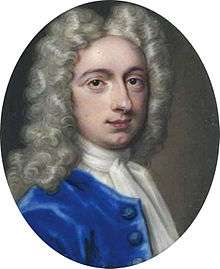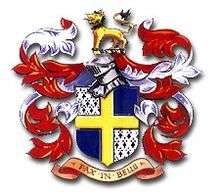Peregrine Osborne, 3rd Duke of Leeds


Peregrine Hyde Osborne, 3rd Duke of Leeds (11 November 1691 – 9 May 1731)[1] was a British peer.
He was the second son of Peregrine, Earl of Danby and his wife, the former Bridget Hyde, only daughter of Sir Thomas Hyde, 2nd Baronet.[2] In 1694, when his grandfather, the 1st Marquess of Carmarthen, was created Duke of Leeds, and his father assumed the title Marquess of Carmarthen, he became Lord Peregrine Osborne. In 1709, he began his Grand Tour together with his older brother William, Earl of Danby,[3] who died of smallpox in Utrecht in 1711, at which point Osborne assumed the title Earl of Danby.[4] In 1712, when his father succeeded as 2nd Duke of Leeds, he became Marquess of Carmarthen. Lord Carmarthen was summoned to the House of Lords in his father's most junior title as 3rd Baron Osborne by a writ in acceleration in January 1713 and succeeded to his father's other titles in 1729.[5]
On 16 December 1712, he married firstly Lady Elizabeth Harley, youngest daughter of the 1st Earl of Oxford and Earl Mortimer.[1] She died in the childbed only a year later and he married secondly Lady Anne Seymour, third daughter of the 6th Duke of Somerset, on 17 September 1719.[1] A son, originated from this marriage, died young.[4] After her death in 1722, he married finally, on 9 April 1725 at St Anne's Church, Soho,[1] Juliana Hele, a daughter and co-heiress of Roger Hele of Holwell in the parish of Newton Ferrers, Devon.[6]
Death & succession
Leeds died aged 40 and was buried in the Osborne family chapel at All Hallows Church, Harthill, South Yorkshire. He was succeeded in his titles by his only surviving child Thomas, Marquess of Carmarthen, born by his first wife.[7]
References
- 1 2 3 4 Cokayne, George Edward (1887). Complete Peerage of England, Scotland, Ireland, Great Britain and the United Kingdom. vol. V. London: George Bell & Sons. pp. 36–37.
- ↑ Burke, John (1832). A Genealogical and Heraldic History of the Peerage and Baronetage of the British Empire. vol. II (4th ed.). London: Henry Colburn and Richard Bentley. p. 68.
- ↑ Spring, Matthew (2006). The Lute in Britain. Oxford University Press. p. 445. ISBN 0-19-518838-1.
- 1 2 Collins, Arthur (1812). Sir Egerton Brydges, ed. Collin's Peerage of England. vol. I. London: T. Bensley. pp. 259–260.
- ↑ Doyle, James Edmund (1886). The Official Baronage of England. vol. II. London: Longmans, Green & Co. p. 329.
- ↑ Risdon, Tristram (d.1640), Survey of Devon, 1811 edition, London, 1811, with 1810 Additions, pp.387-8
- ↑ Debrett, John (1828). Debrett's Peerage of the United Kingdom of Great Britain and Ireland. vol. I (17th ed.). London: G. Woodfall. pp. 18–19.
| Peerage of England | ||
|---|---|---|
| Preceded by Peregrine Osborne |
Duke of Leeds 1729–1731 |
Succeeded by Thomas Osborne |
| Baron Osborne (writ in acceleration) 1713–1731 | ||